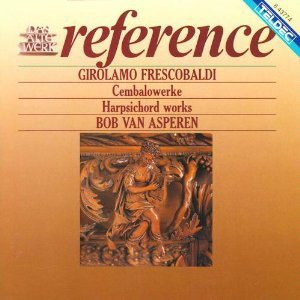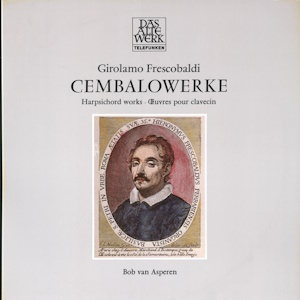 |
| 1 CD -
8.43774 ZS - (c) 1987 |
 |
1 LP -
6.42174 AW - (p) 1977
|
|
CEMBALOWERKE
|
|
|
|
|
|
|
|
|
|
| Girolamo FRESCOBALDI
(1583-1643) |
Toccata
Decima |
aus "Toccate
d'Intavolatura di Cimbalo et
Organo, Partite di diversi arie et
Corrente, Balletti, Ciaccone,
Passachagli, di Girolamo
Frescobaldi, Organista in S.
Pietro di Roma - Libro Primo,
1637" |
|
4' 33" |
1
|
A1 |
|
Cento Partite
sopra Passacagli
|
aus "Toccate
d'Intavolatura di Cimbalo et
Otgano Libro Primo 1637" |
|
11' 35" |
2 |
A2
|
|
Canzona Terza
|
aus "Il secondo libro
di Toccate, Canzone, Versi
d'Hinni, Magnificat, Gagliarde,
Correnti et altre Partite
d'Intavolatura di Cimbalo et
Organo di Girolamo Frescobaldi,
Organista in S. Pietro di Roma,
1637" |
|
3' 44" |
3 |
A3
|
|
Toccata Nona
"Non senza fatiga si giunge al
fine"
|
aus "Il secondo
libro di Toccate... 1637" |
|
5' 16" |
4 |
A4
|
|
Capriccio sopra
la Bassa Fiamenga
|
aus:
"Il primo libro di Capricci, Canzon
francese e Recercari fatti sopra diversi
soggetti, et Arie in partitura,
1626/1642" |
|
5' 20" |
5 |
B1
|
|
Toccata Nona |
aus "Toccate
d'Intavolatura di Cimbalo et
Otgano Libro Primo 1637" |
|
6' 07" |
6
|
B2 |
|
Canzon Terza
detta La Crivelli
|
aus:
"Canzoni alla francese in partitura del
Signor Girolamo Frescobaldi, Organista
di S. Pietro di Roma, Raccolte
d'Allessandro Vincenti - Libro quarto,
1645" |
|
1' 36" |
7 |
B3 |
|
Partite 14
sopra L'Aria della Romanesca
|
aus "Toccate
d'Intavolatura di Cimbalo et
Otgano Libro Primo 1637" |
|
13' 33" |
8 |
B4 |
|
|
|
|
|
Bob
van ASPEREN, Cembalo (Martin
Skowroneck, Bremen 1964, bach einem
italienischen Instrument des 17.
Jahrhunderts)
|
|
|
|
|
Luogo
e data di registrazione |
|
-
|
|
|
Registrazione:
live / studio |
|
studio |
|
|
Producer |
|
-
|
|
|
Prima Edizione
LP |
|
Telefunken
- 6.42174 AW - (1 LP) - LC 0366 -
durata 51' 44" - (p) 1977 -
Analogico
|
|
|
Edizione
"Reference" CD
|
|
Tedec
- 8.43774 ZS - (1 CD) - LC 3706 -
durata 51' 44" - (c) 1987 - AAD |
|
|
Cover |
|
Detail
aus einem barocken Bilderrahmen
mit König David, Musen, Tugenden
und Lastem. Buchsbaumholz /
Holland gegen 1670, mit
freundlicher Genehmigung des
Museums für Kunst und Gewerbe,
Hamburg
|
|
|
Note |
|
-
|
|
|
|
|
The
Italian composer
Girolamo Frescobaldi
(1583-1643) was admired
and revered by his
contemporaries as a
brilliant singer, a
powerful organ and
harpsichord player and
an extraordinary
improvisor. If one can
believe the chroniclers
of yesteryear, his organ
playing (Frescobaldi was
organist at the famous
St. Peters cathedral in
Rome for the last 35
years of his life)
attracted masses of
listeners — sometimes as
many as 30,000 people.
Frescobaldi’s compatriot
and contemporary
Severino Bonini
(1582—1663), one of the
earliest exponents of
the monodic style,
testified to his
considerable reputation
as a practising musician
with the pithy remark:
‘‘Nowadays anybody not
playing according to his
style is not
appreciated”. Another
indication of the
considerable esteem in
wich Frescobaldi was
held also as a composer
during his lifetime is
the fact that the
important composer and
Vienna court organist
Johann Jacob Froberger
(1618-1667) — regarded
as the founder of the
piano suite — studied
for four years with his
older Italian colleague
at the court’s expense.
Although
the image of a brilliant
music personality might
today appear to have
paled somewhat, due to
the enormous distance in
time of three and a half
centuries, the
historical significance
of the most important
representative of early
baroque Italian
instrumental music is by
no means underestimated
by musicology. Thus
Girolamo Frescobaldi is
justifiably regarded as
the great renewer of
Italian instrumental
music at the beginning
of the 17th century, who
combined the polyphonic
techniques and
instrumental forms of
his predecessors Andrea
Gabrieli, Claudio Merulo
and Giovanni Gabrieli in
his work and further
developed them into new
musical qualities.
Together with Claudio
Monteverdi, who in the
field of vocal and
operatic music achieved
epoch-making
significance, it was
Frescobaldi with his
brilliant creative
spirit who led Italian
instrumental music
‘‘from the academic
strictness of form of
the renaissance period
to the strength of
expression, liveliness
and finely jointed
structure of the early
baroque style” (Claudio
Sartori).
Compositions
for organ make up the
most important part of
Frescobaldi’s
wide-ranging creative
work. However, the works
for harpsichord also
play a major role, both
as regards quantity and
quality. Many of his
works — which have been
preserved in exemplary
original printings in
tablature form (i.e., in
the six and eightline
system) and partly also
in copies — were
expressly intended by
Frescobaldi himself to
be played by harpsichord
and organ (“DI CEMBALO
ET ORGANO")
The range
of forms to which
Frescobaldi had recourse
is also diverse. In
addition to Ricecar,
Canzon and Fantasia
- predecessors of the
fugue - there are the
forms of the Toccata,
the Capriccio
and of the Partita.
In his hands these
traditional forms are
developed into artistic
formations of strong
structural uniformity
and major formal
integration. In their
occasionally rich
chromatics and colourful
harmony, their richness
of inspiration and in
their technical
performance virtuoso
style, these works have
maintained their
unbroken effective
strength across the
centuries.
The
present gramophone
record spotlights
Frescobaldi’s
interesting piano style
in the forms of the
Canzone, Capriccio, the
Toccata and of the
Partita. Typical for
Frescobaldi’s canzoni
(examples):
"Canzona
Terza”’ from the “Second
book of toccatas,
canzoni...” and the
“‘Canzon Terza detta la
Crivelli” from "Canzoni
alla Francese’’) are, in
addition to the
development of fugue
expositions, a varied
but nevertheless clearly
structured overall form,
evenly flowing motion,
colourful harmony
influencing the entire
construction and the
adherence to a single
theme which returns in
changing shapes in every
section. This type of
“Variations Canzone”
developed by Frescobaldi
now replaced the former
“‘Contrast Canzone" of
the renaissance.
The
Capriccio, which in form
is related to the
Canzone (example:
‘Capriccio sopra la
Bassa Fiamenga'' from
the ‘First Book of
Capricci, Canzoni and
Ricercare .. ."')
displays greater
independence in
arrangement compared to
the other forms. In
content it is freer and
more multifaceted, and
at the same time clearly
indicates varied
compositional and
performance practice
intentions and emotions.
In the
Toccatas (examples:
“Toccata Nona” and
‘Toccata Decima" from
the “First Book of
Toccatas and Partitas”
and ‘“Toccata Nona” from
the “Second Book of
Toccatas and Partitas. .
."') Frescobaldi reveals
his magnificent art of
playing which was so
greatly admired by his
contemporaries, as
already referred to. The
frequent change from
broad chordal surfaces,
strongly figured and, in
some cases, virtuoso set
passages, as well as
imitative sections
results in wider
emotional diversity and
creates dramatic
tensions.
English
and Dutch variation
techniques, with which
the young Frescobaldi
became acquainted at
first hand during his
stay in Flanders
(1607/08) are reflected
in the Partitas
(examples: “Cento
Partite sopra
Passacagli” and "Partite
14 sopra l'Aria della
Romanesca'' from the
‘‘First Book of Toccatas
and Partitas.... .""). A
musical speciality is
the *'Partite sopra
Passacagli"' with its 14
variations. In this work
elements of the
variation, of the suite
and of the passacaglia
amalgamate to become
music of grand formal
compactness.
A word on
the interpretation of
the Frescobaldi works.
The composer prefaced
his various books of
organ and keyboard works
which appeared in print
with remarks which
contain some revealing
advice on the
interpretation of his
pieces. For instance he
placed especial
importance on a style of
performance which
accorded with the
particular form and the
appropriate tonal
character. Among other
things, he demanded that
the “‘style of play . .
. should not be rigidly
subordinated to the
measure”; which meant
that ‘“‘the measure
should now be played
slowly and then quickly,
or then even suspended,
according to the
expression or meaning. .
.” In the demand for a
“fully expressive’,
“‘lively’’ and
“tasteful”
interpretation,
Frescobaldi thus became
the precursor of an
interpretation style
which was to find its
most consistent
realisation in the
individual rubato
playing of the
nineteenth century.
Siegmar
Keil
English
translation by
Frederick A. Bishop
|
|